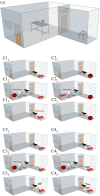New Caledonian crows plan for specific future tool use
- PMID: 33143583
- PMCID: PMC7735258
- DOI: 10.1098/rspb.2020.1490
New Caledonian crows plan for specific future tool use
Abstract
The ability to plan for future events is one of the defining features of human intelligence. Whether non-human animals can plan for specific future situations remains contentious: despite a sustained research effort over the last two decades, there is still no consensus on this question. Here, we show that New Caledonian crows can use tools to plan for specific future events. Crows learned a temporal sequence where they were (a) shown a baited apparatus, (b) 5 min later given a choice of five objects and (c) 10 min later given access to the apparatus. At test, these crows were presented with one of two tool-apparatus combinations. For each combination, the crows chose the right tool for the right future task, while ignoring previously useful tools and a low-value food item. This study establishes that planning for specific future tool use can evolve via convergent evolution, given that corvids and humans shared a common ancestor over 300 million years ago, and offers a route to mapping the planning capacities of animals.
Keywords: New Caledonian crows; comparative cognition; future reward; planning; spoon test.
Conflict of interest statement
All authors declare that they have no conflict of interest.
Figures


Comment in
-
New test, old problems: comment on 'New Caledonian crows plan for specific future tool use'.Proc Biol Sci. 2021 Sep 8;288(1958):20210186. doi: 10.1098/rspb.2021.0186. Epub 2021 Sep 1. Proc Biol Sci. 2021. PMID: 34465238 Free PMC article. No abstract available.
-
New Caledonian crows' planning behaviour: a reply to de Mahy et al.Proc Biol Sci. 2021 Sep 8;288(1958):20211271. doi: 10.1098/rspb.2021.1271. Epub 2021 Sep 1. Proc Biol Sci. 2021. PMID: 34465241 Free PMC article. No abstract available.
References
-
- Suddendorf T, Corballis MC. 2008. New evidence for animal foresight? Anim. Behav. 75, e3 (10.1016/j.anbehav.2008.01.006) - DOI
Publication types
MeSH terms
Associated data
LinkOut - more resources
Full Text Sources

